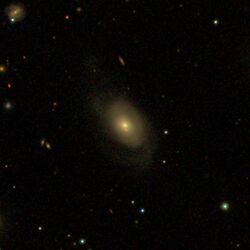Astronomy:NGC 900
From HandWiki
Short description: Lenticular galaxy in the constellation Aries
| NGC 900 | |
|---|---|
 SDSS image of NGC 900 | |
| Observation data (J2000 epoch) | |
| Constellation | Aries |
| Right ascension | 02h 23m 32.18058s[1] |
| Declination | +26° 30′ 41.6759″[1] |
| Redshift | 0.03254[2] |
| Helio radial velocity | 9596 km/s[2] |
| Distance | 428.1 Mly (131.25 Mpc)[3] |
| Apparent magnitude (B) | 15.0[2] |
| Characteristics | |
| Type | S0[2] |
| Other designations | |
| UGC 1843, MCG+04-06-020, PGC 9079[2] | |
NGC 900 is a lenticular galaxy located in the constellation Aries about 430 million light-years[3] from the Milky Way. It was discovered by the German astronomer Albert Marth in 1864.[4][5][6][7]
See also
References
- ↑ 1.0 1.1 Brown, A. G. A. (August 2018). "Gaia Data Release 2: Summary of the contents and survey properties". Astronomy & Astrophysics 616: A1. doi:10.1051/0004-6361/201833051. Bibcode: 2018A&A...616A...1G.
- ↑ 2.0 2.1 2.2 2.3 2.4 "NGC 900". SIMBAD. Centre de données astronomiques de Strasbourg. http://simbad.u-strasbg.fr/simbad/sim-basic?Ident=NGC+900.
- ↑ 3.0 3.1 Crook, Aidan C.; Huchra, John P.; Martimbeau, Nathalie; Masters, Karen L.; Jarrett, Tom; Macri, Lucas M. (2007). "Groups of Galaxies in the Two Micron All Sky Redshift Survey". The Astrophysical Journal 655 (2): 790–813. doi:10.1086/510201. Bibcode: 2007ApJ...655..790C.
- ↑ "New General Catalog Objects: NGC 900 - 949". https://cseligman.com/text/atlas/ngc9.htm.
- ↑ "Your NED Search Results". http://ned.ipac.caltech.edu/cgi-bin/nph-objsearch?objname=ngc+900&img_stamp=YES.
- ↑ "Revised NGC Data for NGC 900". http://spider.seds.org/ngc/revngcic.cgi?NGC900.
- ↑ Ford, Dominic. "The galaxy NGC 900 - In-The-Sky.org" (in en). https://in-the-sky.org/data/object.php?id=NGC900.
External links
 |

